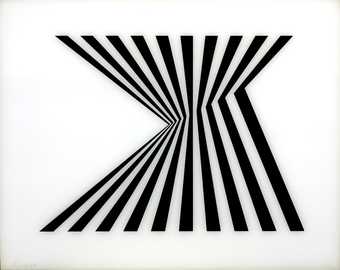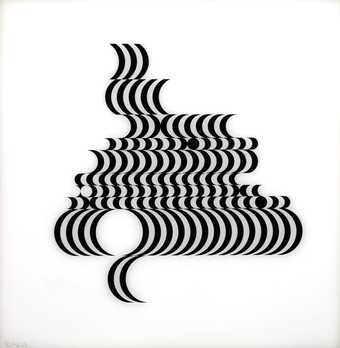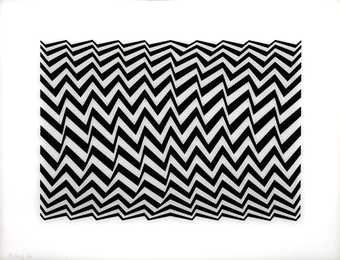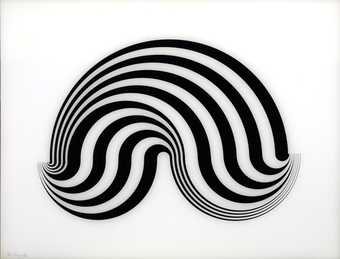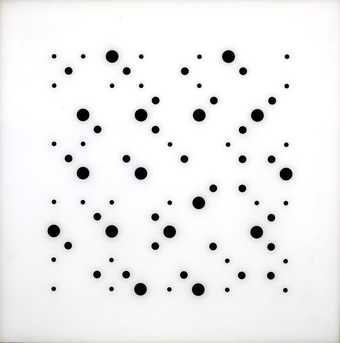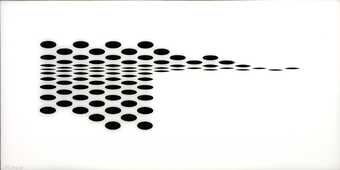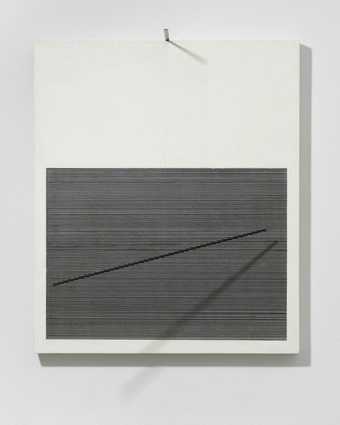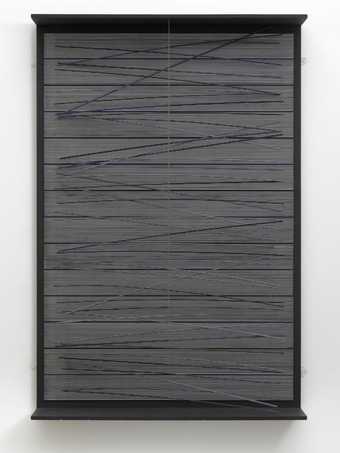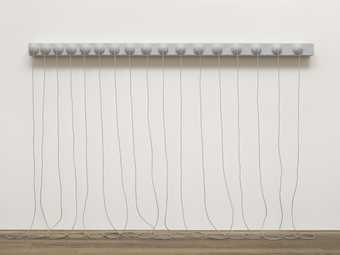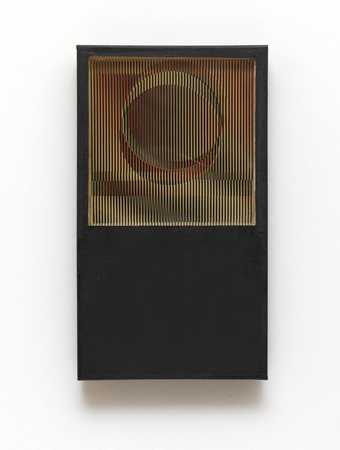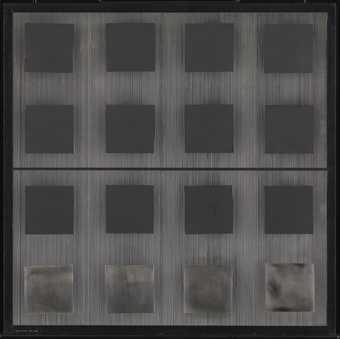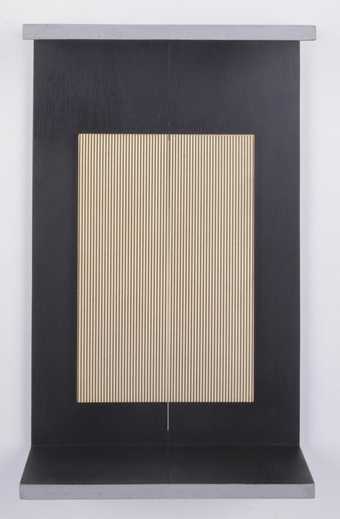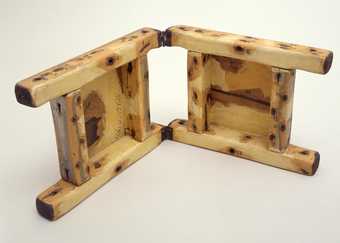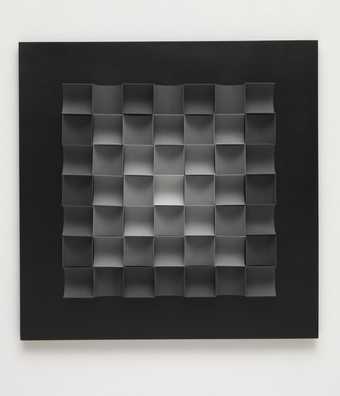
In Tate Liverpool
- Artist
- Ivan Picelj 1924–2011
- Medium
- Wood and metal
- Dimensions
- Object: 588 × 588 × 60 mm
- Collection
- Tate
- Acquisition
- Purchased with funds provided by the Russia and Eastern Europe Acquisitions Committee 2016
- Reference
- T14675
Summary
Surface IX 1962 is a square-format wooden relief on a square wooden backboard which has been painted black by the artist. The relief itself is composed of twenty-seven vertical slats of wood of equal height and width, placed adjacent to one another. Each wooden slat has been machine-routed, or turned, creating a pattern of horizontal indentations at varying intervals along the slats. The profile of each moulded strip is undulated, some strips containing as few as thirteen notches, others as many as nineteen. Each profile becomes a different structural element in the constructed relief. Placed side-by-side, the alternating profiles create a sense of rhythm and movement. Surface IX belongs to a body of wooden reliefs that Picelj created between the late 1950s and the early 1960s to which he gave the name ‘surfaces’, differentiating them from each other by using the roman numerical system.
Having developed his own particular variant of abstract geometric painting during the 1950s, Picelj began making wooden reliefs towards the end of that decade. One of the earliest, the horizontal relief Surface 1957–61 (private collection), is composed of slender strips of unpainted wood, equally spaced across a wooden ground and machine-cut at intervals, creating a three dimensional vibrating surface. When viewed from different angles, or with light reflecting on the surface, the sense of movement is accentuated. The painted wooden relief Surface I 1961 (800 x 800 mm) was exhibited in the first New Tendencies exhibition which took place from 3 August to 14 September 1961 at the Galerija suvremene umjetnosti (Gallery of Contemporary Art), Zagreb. From 1961 to 1969, Zagreb was host to a series of five exhibitions under the banner of New Tendencies, which were connected in their orientation towards neo-constructivist optical art, as well as kinetic and programmed art (‘arte programmata’). New Tendencies was an international movement of European artists and theorists who sought to establish a position that was distinct from abstract expressionism and tachisme. It advocated a new conception of art experimenting with the visual investigation of surfaces, structures and objects, and a methodically planned artistic practice based on research and the active participant. Artists from Austria, France, Germany, Italy and Switzerland, including Julio Le Parc, Heinz Mack, Piero Manzoni, François Morellet, Otto Piene, Dieter Roth and Günther Uecker, participated alongside Picelj and fellow Croatian artist Julije Knifer (1924–2004) in the first New Tendencies exhibition. In the accompanying exhibition catalogue, Picelj explained that the aim of his research was ‘to make art imperceptible’ (quoted in Rosen 2011, p.83).
The following year, at the exhibition New Tendencies 2 (1 August to 15 September 1963), Picelj exhibited the wooden relief Surface XII 1962, now held in the collection of the Museum of Contemporary Art (MSU), Zagreb. This work shares formal similarities with Surface IX in its regular arrangement of routed wooden strips on a square ground. The catalogue accompanying the second New Tendencies exhibition included a short commentary by Picelj in which he spoke of an ‘active’ art which should imperceptibly permeate society:
A large number and multiple meanings of today’s society and individual’s needs require from us to accept active art, able to be the avant-garde of most positive efforts of science and humankind in general … It is imposed on us as a necessity that will establish the relations of true human assets within the framework of a higher structural order. Active art will be realized when elements it consists of become identical. Identical does not mean the same, but subjected to higher structural order; the characteristics of elements will match when they are encompassed by the notion of higher structural order. Subjected to a higher structural order, active art should contain all the elements that will make it part of this entire order, on the scale man-planet-space.
(Quoted in ibid., p.123.)
Picelj made a number of black painted reliefs which were similar to Surface IX, such as Surface VI 1961 (Museum of Contemporary Art, Zagreb), Surface XXII 1962 (private collection), Surface XI 1962 (private collection), Surface VII 1962 (private collection), Surface XII 1962 (Museum of Contemporary Art, Zagreb), Surface XXI 1962 (private collection) and Surface XXI 1962 (private collection). He experimented with optical effects by incorporating wooden strips of differing widths and by alternating the depth and regularity of the indentations. As with Surface IX, the vertical elements within each relief lend the work a totemic quality. From 1964 he began experimenting with making reliefs in metal instead of wood, exploiting the reflective and therefore potentially dynamic qualities of his new medium (see, for example, Suasum 1965 [Tate T14676]).
Surface IX was first exhibited in New York in 1965 at the Howard Wise Gallery, which specialised in constructivist art, kinetic art and light sculpture. It was American art critic Douglas MacAgy who had introduced Picelj’s work to Howard Wise and proposed to Picelj that he exhibit at the gallery. In a letter dated 25 May 1965, MacAgy had written to Picelj noting: ‘Last June I had the pleasure of meeting you in Venice through Madame Denise Rene [a Parisian gallerist specialising in kinetic art and op art] … At that time I knew your work mainly from hearsay and a reproduction or two. But your piece in The Museum of Modern Art’s “Responsive Eye” exhibition [25 February to 25 April 1963] captivated me.’ (Quoted in Museum of Contemporary Art, Zagreb 2014, p.11.) MacAgy’s proposal resulted in the artist sending nineteen reliefs, including Surface IX and Suasum, and three paintings, which were shown in relation to the work of Brazilian constructivist Abraham Palatnik (born 1928) in the exhibition entitled Cinecromaticos by Abraham Palatnik of Brazil; Površine by Ivan Picelj of Yugoslavia: Two One-Man Shows (12 to 30 October 1965). Due to bureaucratic difficulties at the time, it was not possible to transport the works back to socialist Yugoslavia and they remained in storage in New York for over four decades. Thirteen works, including Surface IX and Suasum, were reunited with the estate of the artist in 2013 and exhibited for the first time since 1965 in the exhibition Merci Picelj at the Museum of Contemporary Art (MSU), Zagreb in 2014.
Further reading
Margit Rosen (ed.), A Little-Known Story about a Movement, a Magazine, and the Computer’s Arrival in Art. New Tendencies and Bit International, 1961–1973, Karlsruhe, Cambridge, MA and London 2011.
Merci Picelj. From the Ivan Picelj’s Archives and Library, exhibition catalogue, Museum of Contemporary Art, Zagreb 2014, reproduced pp.10–11.
Juliet Bingham
March 2016
Does this text contain inaccurate information or language that you feel we should improve or change? We would like to hear from you.
Explore
- abstraction(8,615)
-
- non-representational(6,161)
-
- geometric(3,072)
- monochromatic(722)
- formal qualities(12,454)
-
- repetition(391)
- sequence(156)
- texture(466)
You might like
-
Bridget Riley Untitled [Fragment 1/7]
1965 -
Bridget Riley Untitled [Fragment 2/10]
1965 -
Bridget Riley Untitled [Fragment 3/11]
1965 -
Bridget Riley Untitled [Fragment 5/8]
1965 -
Bridget Riley Untitled [Fragment 6/9]
1965 -
Bridget Riley Untitled [Fragment 7/5]
1965 -
Jesus Rafael Soto Horizontal Movement
1963 -
Jesus Rafael Soto Cardinal
1965 -
Mary Martin Inversions
1966 -
Eva Hesse Addendum
1967 -
Carlos Cruz-Diez Physichromie No. 123
1964 -
Jesus Rafael Soto Twelve Blacks and Four Silvers
1965 -
Jesus Rafael Soto Light Trap
1965 -
Paul Neagu (White) Tactile Object with Hinges
1969 -
Ivan Picelj Suasum
1965

